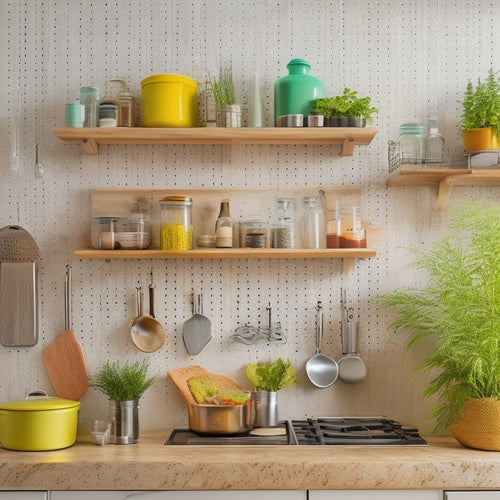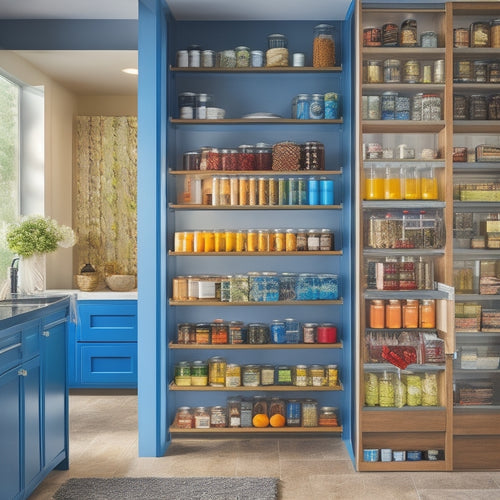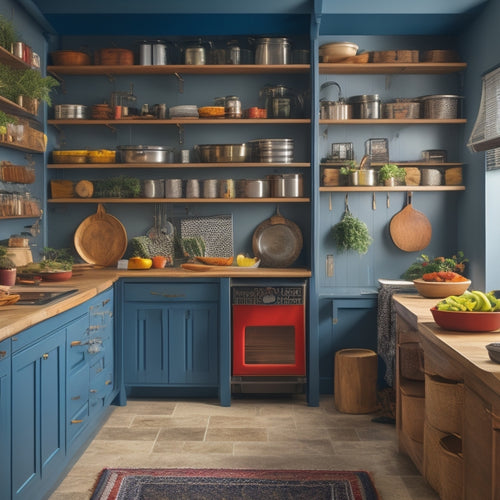
Safely Storing Food: Allergy-Friendly Kitchen Solutions
Share
You need a kitchen that's not only functional but also safe and allergy-friendly, where food storage and preparation are designed to prevent cross-contamination and accidental exposure. To achieve this, prioritize your kitchen's layout to minimize cross-contamination and invest in customized utensils and color-coded storage solutions. Use airtight containers with transparent lids and stackable designs to store food safely. Assign specific zones for prep, cooking, storage, and cleaning to maintain organization and reduce risks. By implementing these strategies, you'll be well on your way to creating a safe and efficient kitchen environment. Now, explore additional solutions to make sure your kitchen is fully equipped to handle food allergies.
Key Takeaways
• Designate separate zones for prep, cooking, storage, and cleaning to minimize cross-contamination and ensure easy cleaning.
• Use color-coded storage and labeling to identify and separate allergenic ingredients, ensuring proper handling and storage.
• Implement sealed containers and shelving for easy access and organization, preventing cross-contamination and extending shelf life.
• Establish regular deep cleaning schedules with allergy-friendly, non-toxic cleaning products to maintain a sanitized kitchen environment.
• Vet suppliers for allergen control practices and request allergen information to ensure safe and reliable ingredient sourcing.
Designing an Allergy-Aware Kitchen
When designing an allergy-aware kitchen, you'll want to prioritize a layout that minimizes cross-contamination and guarantees easy cleaning, starting with the strategic placement of key appliances and workstations. This thoughtful approach will help prevent accidental exposure to allergens and make meal prep a breeze.
To take it a step further, consider investing in customized utensils, such as separate sets for gluten-free, nut-free, or dairy-free cooking. This will eliminate the risk of cross-contamination through shared utensils.
Color-coded storage is another clever solution, allowing you to categorize and store ingredients according to their allergenic potential. For instance, you can designate specific bins or shelves for gluten-free flours, nut-free snacks, or dairy-free alternatives.
Labeling and Signage Essentials
By implementing a clear and consistent labeling system, you can ensure that everyone in the kitchen knows exactly what ingredients are stored in each container, reducing the risk of accidental exposure to allergens. This is vital in an allergy-friendly kitchen, where labeling protocols and safety precautions are essential. A well-designed labeling system guarantees that everyone can quickly identify the contents of each container, making it easier to avoid cross-contamination and allergic reactions.
Here are some essential labeling and signage elements to take into account:
| Label Element | Description |
|---|---|
| Ingredient list | Clearly lists all components used in the recipe |
| Allergy alerts | Highlights common allergens, such as peanuts or gluten |
| Storage instructions | Provides guidance on proper storage and handling |
| Expiration dates | Indicates when the contents should be consumed or discarded |
| Preparation notes | Offers additional information on preparation and serving |
Sealed Containers for Safety
You take the next step in creating an allergy-friendly kitchen by selecting sealed containers that prevent cross-contamination and keep ingredients fresh. This essential step guarantees food safety and minimizes the risk of allergic reactions.
When choosing containers, consider the following vital features:
-
Airtight containers: Prevent air from entering the container, maintaining ingredients' freshness and avoiding moisture buildup.
-
Transparent lids: Allow for easy identification of contents, reducing the risk of accidentally picking the wrong ingredient.
-
Stackable design: Maximizes storage space and keeps your kitchen organized.
-
Easy-to-clean surfaces: Prevent residue buildup and make cleaning effortless.
-
Durable materials: Withstand daily use and cleaning without compromising their structural integrity.
Shelving for Easy Access
Optimizing your kitchen layout with shelving designed for easy access guarantees that essential ingredients and cooking tools are always within reach, saving you time and reducing the risk of accidents. By installing adjustable shelves, you can customize the storage space to accommodate items of varying sizes, from large containers to small spice jars. This flexibility assures that everything has a designated place, making it easier to find what you need quickly.
In addition to adjustable shelves, consider incorporating pull-out drawers into your kitchen design. These convenient storage solutions allow you to access items in the back of the cabinet without having to dig through everything in front of them. This is especially useful for heavy or bulky items, such as cookbooks or large utensils, which can be difficult to maneuver.
Assigning Zones for Safety
Creating a safe cooking environment starts with assigning zones within your kitchen, where specific tasks are performed and specific ingredients are stored, allowing you to manage cross-contamination and minimize the risk of allergic reactions.
By designating specific areas for different activities, you'll prevent cross-contamination and make certain that allergenic ingredients aren't accidentally introduced into safe zones.
Here are some tips to help you assign zones for safety:
-
Prep Zone: Designate a specific area for food preparation, such as chopping and dicing, to prevent cross-contamination of utensils and surfaces.
-
Allergen Zone: Store allergy-prone ingredients, like nuts or gluten, in a separate area to prevent accidental exposure.
-
Cooking Zone: Identify a specific cooking area for each type of cuisine or dietary requirement, ensuring that utensils and cookware aren't shared between zones.
-
Storage Zone: Organize your pantry and storage areas by ingredient type, making it easier to identify and access safe options.
-
Cleaning Zone: Designate a specific area for cleaning and sanitizing utensils and equipment to prevent cross-contamination.
Cleaning and Sanitizing Routines
Implementing consistent cleaning and sanitizing routines is essential to preventing the spread of allergens and maintaining a safe cooking environment. You can't assume that a quick wipe-down is enough; instead, establish a regular schedule to deep clean high-touch areas, appliances, and utensils. This will help eliminate cross-contamination and reduce the risk of allergic reactions.
When it comes to cleaning, opt for allergy-friendly products that are free from harsh chemicals and fragrances. Look for gentle, non-toxic alternatives that are specifically designed for sanitizing surfaces and equipment. Remember to always read labels carefully and follow instructions for proper use.
Proper sanitation and storage go hand-in-hand. Make sure to wash and sanitize containers, utensils, and equipment before storing them. Label and date items to make sure you're using the oldest products first. By prioritizing proper sanitation and storage, you'll create a safe and healthy environment for everyone in your care.
Adaptable Storage for Variety
You'll need a flexible storage system that can accommodate a variety of ingredients, cooking supplies, and equipment to cater to different dietary needs and preferences. This is especially important in an allergy-friendly kitchen, where customization is key. To achieve this, look for adaptable storage solutions that offer versatile organization options.
Some ideas to get you started include:
-
Adjustable shelving units that can be customized to fit different-sized containers and equipment
-
Stackable bins and baskets with labels to keep similar items together
-
Over-the-door storage racks for spices, oils, or snacks
-
Expandable drawer dividers to separate utensils and cooking tools
-
Modular cabinets with interchangeable shelves and drawers to maximize storage capacity
Emergency Response Planning
Your allergy-friendly kitchen should have a clear plan in place for responding to accidental exposures or reactions. It's essential to develop a thorough emergency response strategy that outlines steps to take in case of an allergic emergency.
This plan should include training protocols for all kitchen staff. This training should cover how to recognize the signs and symptoms of an allergic reaction, how to administer epinephrine using an EpiPen or other auto-injector, and what to do in case of an anaphylactic reaction.
Effective communication strategies are also vital. Staff should be trained on how to quickly alert other team members, how to contact emergency services, and how to provide important information to first responders.
Additionally, make sure to have a system in place for tracking and reporting allergic reactions. This includes documenting the reaction, the treatment given, and any follow-up care.
Frequently Asked Questions
How Often Should I Replace My Food Storage Containers?
Like a trusted friend, your food storage containers have a limited lifespan. Typically, you should replace them every 5-7 years, considering container longevity, storage temperature, and proper disposal techniques to guarantee freshness concerns don't turn into safety issues.
Can I Reuse Containers That Previously Held Non-Allergy-Friendly Foods?
When reusing containers that previously held non-allergy-friendly foods, you must prioritize container sanitation to avoid cross-contamination risks. Prioritize proper cleaning techniques and allergy-friendly labeling to guarantee safe storage and serving for those with dietary restrictions.
What Is the Recommended Storage Temperature for Common Allergens?
When storing common allergens, you maintain proper storage by keeping a consistent refrigerator temperature below 40°F (4°C) and freezer temperature at 0°F (-18°C), reducing cross contamination and facilitating accurate allergen detection.
Can I Store Allergy-Friendly and Non-Allergy-Friendly Foods Together?
You're wondering if you can store allergy-friendly and non-allergy-friendly foods together? Think again! Cross contamination risks are too high, so it's best you opt for separate storage to keep everyone safe and healthy.
How Do I Safely Dispose of Expired or Spoiled Allergy-Friendly Foods?
When disposing of expired or spoiled allergy-friendly foods, you'll want to prioritize safe disposal to prevent cross contamination and minimize food waste. Check expiration dates, then wrap and seal items tightly before throwing them away to prevent leakage.
Related Posts
-

Stylish Pegboard Storage for Open Kitchen Concepts
Stylish pegboard storage can completely enhance your open kitchen concept, merging practicality with contemporary fla...
-

Sliding Pantry Organizers With Tiered Racks
Sliding pantry organizers with tiered racks optimize your pantry space and enhance accessibility. These organizers cr...
-

Over-The-Door Kitchen Storage for Large Families
Over-the-door kitchen storage is a transformative solution for large families. It maximizes vertical space, keeping y...


